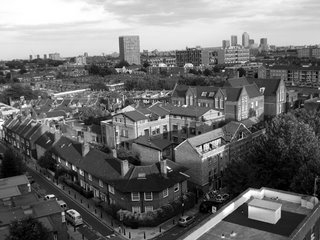





This morning I decided to cycle along Bethnal Green Road on my way to the office. Thus I could not avoid to stop by the place Joana was alway talking about as one of the most true corners of Italy in London. Caffè Pellicci was founded by a family from tuscany in 1900 and since then has been delighting the Londoners with gourgeous breackfasts and lunches. It is best known beacuse it has been the hearth of gangster and mafia stories in the 50s.
Me - today I have been sitting here at breackfast time, reading the Guardian (did I ever say this is my favourite newspaper?), sipping from a very good cappuccino (obvious / banal!) and tasting THE BEST EVER apple and blackcurrant cruble with custard!!! and I managed to take these 2 pictures but to me shooting inside this place was like braking a familiar picture with coarseness. I will combine them with images froma web archive - because they seem more authentic? more because they amuse me.
Italian cafe gets the cream | The Guardian | 23 February 2005 | by Mark GouldThe backlash against the Starbucking of the high street has started, announced caff aficionado Adrian Maddox at the news that Pellicci's, a tiny time capsule of a caff that has stood in the East End of London for 105 years, has been given listed building status.
'Fuck me, is it that important?' said equally amazed owner Nevio Pellicci as he raced around the Formica tables serving up gargantuan breakfasts at 7am, 'Your not having me on are you?'
Pellicciís has been in the same family since it was built in 1900. Nevio was born above the shop 79 years ago. And English Heritage is not having him on.
Recommending Grade II listing inspectors lovingly describe it as having a 'stylish shop front of custard Vitrolite panels, steel frame and lettering as well as a rich Deco-style marquetry panelled interior, altogether representing an architecturally strong and increasingly rare example of the intact and stylish Italian caf that flourished in London in the inter-war years'.
But they also issued a warning: 'The 50s caf is indeed becoming increasingly rare and the recent proliferation of new chain coffee shops is threatening their economic viability.'
Around 2000 Italian owned cafes and coffee bars flourished in the UK after the Second World War. Maddox, whose website www.classiccafes.co.uk is part memorial to the departed and part calls to arms, estimates that fewer than 500 remain.
He says they have been forced out by massive rent rises and what he calls 'a campaign of corporate cultural napalming' by the coffee chains.
He says these old cafes created an artistic and social cohesion that can't be invented by corporate chains desperate to create ersatz atmosphere.
'Music, fashion, film, advertising, photography, sex, crime, the avant-garde. The cafes were the creative enclaves where it was all honed. They added an impassioned European vibrancy to Britain's deflated post-war social, artistic and commercial scene - all we get from the coffee giants is McCappuccino jobs and Clone Town high streets'.
Pellicci's has its own place in popular culture. It was a meeting place of the notorious Kray gang who lived just around the corner in Voss Street.
Nev's son Nevio junior pulls out an autograph book stuffed with signed pictures of more recent Pellicci worshippers: a sunburst of soap stars, tabloid faces and Page 3 stunners.
It's also part of the fabric for Iain Sinclair, chronicler of weird resonances of the East End, who has been a devotee since the 1960s (see interview in Classic Cafes).
The caff is a focus and social hub of the area. Nevio is small and immaculately turned out in shirt, tie and zippered pullover and matinee idol pencil moustache. He knows everyone and everyone knows him.
And he thanks a sharp-eyed customer for saving the caf from being burnt down in 1999: 'It was about 11 o'clock at night and a regular was driving past in his cab and noticed what he thought were lights on in the kitchen. He stopped and saw it was a fire and phoned the Fire Brigade. They were here very fast and managed to save us.'
One of the many regulars who have been eating here for decades explains the Pellicci strategy: 'He gets you in with them,' he says pointing to a row of brilliant coloured sarsaparilla bottles sitting in the front window, 'you pester your mum and she brings you in and your hooked.'
Nevio Pellicci says the listing is 'a great honour' but he has one dispute with the inspectors. The Vitrolite panelling is primrose not custard.
But he says the tributes should go to his mother Elide who supervised the art-deco style marquetry interior created by in 1946 one of the best local carpenters - Achille Capocci.
'Around here was all carpenters, they all knew each otherís work, but mum wanted Capocci to do the marquetry as he was the best - everyone could tell his work.'
And as a tribute to Elide Pellicci, Capocci placed central marquetry plaque marked 'EP' in a place of honour along the panelling behind the counter.
It's the 1946 work that is so significant for English Heritage: 'This work was fitted in the context of the period just after the war. This was the year of the Britain Can Make It exhibition at the Victoria and Albert Museum, heralding modern British design, and a few years later the Festival of Britain brought a style and design awakening to the Capital. It was also a period of increased Italian immigration and a great number of new cafes and espresso bar started to open up - a modern continuation of a long London tradition that started with 17th century coffee houses.'
So will Nevio be leaving the marquetry and Vitrolite to a coffee chain when he retires? 'Over my dead body.'
A well-breakfasted customer puts down his Star and laughs: 'I always said you was in institution, or should be in one, Nev.'
























